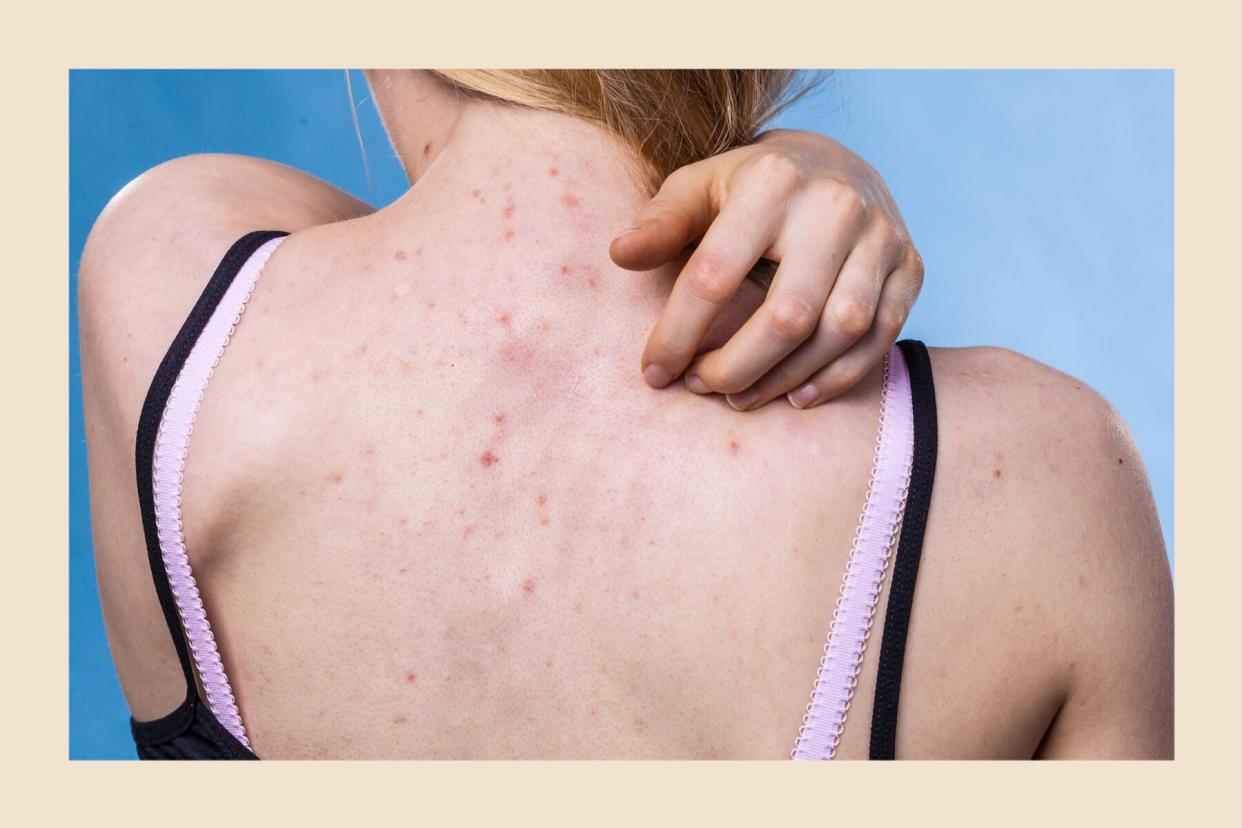Your Haircare Products Might Be Causing Your Bacne

Getty Images
Welcome to The Spot, a monthly column tackling acne and our relationships to it. Here, we ask women how they deal with blemishes at home—and consult with skin care experts to find out what really works.
Acne is a fact of life. It's the most common skin condition, affecting almost 50 million adult Americans a year, yet it can still be incredibly frustrating to deal with. This rings especially true if you can't figure out what's causing your pimples. Is it hormones? Genetics? Stress? Diet? (Sometimes, it's all of the above.) There's one culprit, however, that you may not have considered: your hair products.
No matter the length of your hair, your haircare products are bound to get on your skin, whether that's from rinsing down your body in the shower or from rubbing against your face while you sleep. In fact, a 2020 study led by board-certified dermatologist Iris Rubin, M.D., found that hair product residue can transfer from the hair—or a towel or pillowcase—to the skin and stay there for two to four hours after use. For that reason, Dr. Rubin tells HelloGiggles we should really be considering that "hair care is skin care."
So, how exactly do haircare products cause acne? Well, in the same way that skincare products can. Just as skincare products can be comedogenic (pore-clogging), so can hair care products. If you have oily or acne-prone skin, Dr. Rubin says your shampoo, conditioner, and/or leave-in products could be contributing to acne on your face, neck, and back.
Keep reading to learn how to tell if hair care products are causing your face and body acne, and what you can do about it if they are.
Are haircare products causing your breakouts?
Because there are so many potential contributing factors to acne, it can be hard to pinpoint one single culprit. However, Dr. Rubin says there are a few ways to determine if your hair care might be (at least partially) to blame for your breakouts.
Check the location of your breakout.
If you're consistently breaking out along the hairline, back of the neck, and on your back, (aka, "areas of high contact with hair products"), Dr. Rubin says there's a pretty good chance that your hair products are to blame. Just as breakouts around the chin and jawline can signify hormonal acne, breakouts on the back, neck, and hairline, can potentially signify a reaction to contact with products.
Dr. Rubin also notes that bacne (back acne) can commonly be caused by sweat and clothing as well. "If you exercise and wear tight clothing, that can be a contributor [to body acne] as the tight clothes can trap the sweat, which can mix with dead skin cells and bacteria on the skin." For that reason, she also encourages people to remove tight clothing and wipe off sweat as quickly as possible after exercise.
2. Consider your skin type.
While anyone can experience body or face acne and for a number of different reasons, Dr. Rubin says you're most likely to get breakouts from comedogenic hair care products if you're skin is oily or acne-prone. Not sure what skin type you have? Take our test to find out.
3. Change your haircare products.
One of the best ways to determine if your haircare products are causing your acne is to stop using them and see what happens. This doesn't mean you have to become a haircare minimalist, you just have to find more skin-friendly products and see if those make the difference in your breakouts.
Keep reading to find out exactly what to look for when searching for new products.
What to look for or avoid in hair care products:
Avoid: coconut oil
Both Dr. Rubin and board-certified dermatologist Hadley King, M.D., put coconut oil on top of the list of acne-causing ingredients to avoid in haircare products. While coconut oil can be great for adding hydration and shine to hair, it's a well-known comedogenic, meaning it can lead to breakouts on the skin. Dr. Rubin also adds that cocoa butter can be highly comedogenic for many people and is worth avoiding as well.
Look for: non-comedogenic formulas
While Dr. Rubin cautions against some specific ingredients, such as coconut oil, she says that preventing product-caused breakouts is a bit more complicated than avoiding just a few ingredients. "There's not a lot of data on a lot of ingredients," she explains. "So, you might have a shampoo that has 20 ingredients in it, and you only have data on comedogenicity for a handful, and since a lot of it's [tested] on animals, it's not always applicable to humans."
For that reason, she says, it's more effective to look for hair products that are tested holistically—from start to finish—to be non-comedogenic and skin-friendly. This is exactly what the haircare brand SEEN, which Dr. Rubin founded, does. In addition to being free of potentially irritating or damaging ingredients such as sulfates, silicones, and dyes, all of SEEN's products are tested and proven to not clog pores or cause breakouts. In a 2021 dermatologist-graded study on participants with body acne, 70% of participants saw improvement with body acne after using SEEN products.
- 29 Available at Ulta
- 26 Available at Ulta
Look for: salicylic acid
This common acne-fighting ingredient isn't just found in skincare products. "Salicylic acid is an ingredient used in some shampoos to help with dandruff and scalp acne because it penetrates into pores to gently exfoliate and remove excess oils," Dr. King explains. "If you're prone to acne on the scalp and/or body areas adjacent to the scalp, then try a shampoo that contains salicylic acid."
- 5.26 Available at Target
This Neutrogena T/Sal Scalp Build-Up Control Therapeutic Shampoo is formulated with 3% salicylic acid to break down scalp build-up and can double as a powerful body acne-fighting resource. If you're prone to an oily scalp and skin, this product packs a great two-in-one punch.

